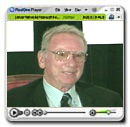Irwin Jacobs at SD Telecom Council
October 12, 2004 -- In September, QUALCOMM founder and CEO Irwin Jacobs spoke to the San Diego Telecom Council for the first time in six years. He was interviewed by wireless analyst Andrew Seybold, and took questions from the audience. "From Qualcomm's point of view, we are still a startup, but one with a very good cash flow," Jacobs said. "I want everyone in the company to think about new ideas to grow the company."
|
In his comments, Jacobs noted the impact that the company's code division multiple access (CDMA) technology has had on the industry and the region. "As wireless has grown in popularity, and CDMA has become the technology of the third generation, a number of other companies have moved into the area as well," he said. "This has created what some have called a 'cluster' of telecom companies in San Diego."
While the bulk of QUALCOMM's payroll is still in San Diego, Jacobs also reminded the audience that the company is expanding elsewhere, and has opened research centers in other places to focus on specific R&D tasks, for example digital signal processing in Austin, and putting more computing capability on QUALCOMM chips in North Carolina. "On CDMA, there's another good decade of excitement happening before us," said Jacobs. "But we also need to be looking in other areas as well."
The wireless pioneer who played a key role in the launch of Calit² -- including QUALCOMM's $15 million early pledge to match state funds for the institute -- also lauded the important role that higher education plays in the San Diego economy. "UCSD, San Diego State and other colleges here have continued to grow and accomplish all kinds of things," said Jacobs. "San Diego is a very exciting place and hopefully Qualcomm will continue to contribute, and I suspect many other companies will contribute as well."
Jacobs spoke about the mobile communications revolution which has evolved from an expensive and localized workforce tool with only a few vendors offering products, into a global, mass market phenomenon with new consumer electronics vendors joining traditional cell phone manufacturers in the field. The former engineering professor at UCSD also spoke about the transformation of both QUALCOMM and the wireless industry as the transition from second-generation to third-generation technologies accelerates. Jacobs touched on the latest developments in the industry, from location services and multi-megapixel cameras, to amazing applications, and even digital video -- all in the subscriber's phone.
The meeting was videotaped and provided to Calit² by the SD Telecom Council and QUALCOMM, Inc.
Related Links
QUALCOMM, Inc. www.qualcomm.com
SD Telecom Council www.sdtelecom.org


